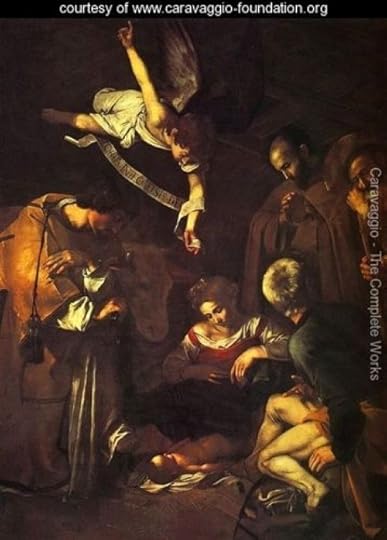Daily Caravaggio: Nativity with Saints Francis and Lawrence
On the run Caravaggio painted a work that's now on FBI Most Wanted list

Caravaggio's Nativity with St Francis and St. Lawrence is one of the FBI's Top 10 Most Wanted works of art. It was stolen from a church in Palermo in 1969, probably by the Mafia. Various mafiosi have since then claimed it was destroyed before it could be sold to private collectors. Well, they would, wouldn't they.
In some ways, the painting was linked to crime from the moment of its creation. Caravaggio had fled to Sicily from Malta because of a fight with a knight. (He had fled to Malta from Rome, because he killed a pimp.)
To coincide with the UK paperback publication of my Caravaggio novel A NAME IN BLOOD, I'm posting each of the paintings that appear in the book this month along with a snippet from the novel.
Here Caravaggio awakes in the studio where he's painting the Nativity. Haunted, pursued, and fearful:

Caravaggio's Nativity with St Francis and St. Lawrence is one of the FBI's Top 10 Most Wanted works of art. It was stolen from a church in Palermo in 1969, probably by the Mafia. Various mafiosi have since then claimed it was destroyed before it could be sold to private collectors. Well, they would, wouldn't they.
In some ways, the painting was linked to crime from the moment of its creation. Caravaggio had fled to Sicily from Malta because of a fight with a knight. (He had fled to Malta from Rome, because he killed a pimp.)
To coincide with the UK paperback publication of my Caravaggio novel A NAME IN BLOOD, I'm posting each of the paintings that appear in the book this month along with a snippet from the novel.
Here Caravaggio awakes in the studio where he's painting the Nativity. Haunted, pursued, and fearful:
In the dawn, he was alone. The outlines of his few belongings, the easel he had built on arrival in Palermo, the glimmer of the early light on the tacks attaching his canvas to its frame – this was all the life left to him now. The sun illuminated these objects, but no companion watched it fall across his face.
He lay on his front, fully dressed and with his arms outstretched, like a man who had been assaulted by an attacker approaching unseen from behind. In the heat of the summer, he sweated through the nights, clothed and armed for a quick getaway in case his murderer should come. Shapes moved in the shadows and he tracked them, holding his breath. The shutters creaked as the wood expanded in the heat of the first sunshine. Their every click and rasp made his heart thrash.
Perhaps his killers would come today. I’d almost welcome the company.
He imagined the saints in the dawn of the day of their martyrdom. They had consolations unknown to him. They were certain of the fate of their souls. But when he pictured their deaths, he saw the bodies they left behind. Slaughtered, bloodless meat.
He leaned over his tray of pigments. ‘Good morning, my only friends,’ he murmured. The clay dug near Siena, filled with iron and making a yellow-brown oil, or burned in a furnace for the red-brown he loved to use; red ochre also from the Tuscan hills, and St John’s White, made from quicklime by Florentine monks; green earth quarried near Verona; and the most expensive, ultramarine blue, ground from lapis lazuli that was mined in the land of the Khans beyond Persia – he touched them all. They were like a cooling salve on a wound.
He descended the stairs to the kitchen. An old Franciscan monk laid a bowl of thin cabbage soup before him. ‘How’s our Nativity progressing, Maestro Michele?’
‘Almost done.’ Caravaggio had finished the canvas two days before. He lingered over it, fearful of what he might encounter if he were to leave his studio.
‘God bless you, Maestro. Where will you go when it’s completed?’
The minced cabbage in the soup was sparse. He noted the skin of a bean floating in the broth, but when he trawled his spoon through the dish he found no trace of the rest of it. ‘I haven’t considered that, Brother Benedetto.’
Only when he was working did he not feel as though he were heading downhill. He tried not to think about the future, because he knew the dangers and hardships he faced. He could hardly explain that to the monk. The Franciscans sought out mortification of the flesh among the poor. For all he knew, Brother Benedetto had skinned the bean and thrown away its meat when he made the soup.
Published on September 16, 2013 01:10
•
Tags:
art-history, caravaggio, covers, crime-fiction, food, historical-fiction, italy, rome
No comments have been added yet.



